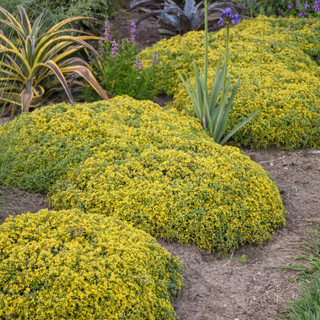
Purslane
Uses:
- Groundcovers
- Containers & Planters
- Waterwise Gardens
Features:
- Drought Tolerant
- Attracts Pollinators
- Re-Blooming
Sunlight:
- Full Sun
- 6+ Hours of Direct Sun
Growing Zones:
- 10-11
- Typically Grown As An Annual
- What is My Zone?
Purslane, often called Portulaca, is a drought tolerant flowering plant that is often grown as a low maintenance annual. The low growing plant can be a spiller in containers, or grows as a groundcover in the garden.
About Purslane

Moss Rose, Sun Plant
South Asia
Annuals
Deciduous, Herbaceous
4 - 11
Red, Pink, Yellow, Orange, White, Purple
Late spring to fall
Spreading, Trailing
Bees, Butterflies
Drought, Heat
Deer, Rabbits, Voles, Moles, Diseases, Pests
How To Use Purslane In The Garden
Purslane dazzles with bold blooms in shades ranging from tangerine to pink, each perched on fleshy green foliage that thrives in scorching conditions. This low-profile annual rarely sulks over poor soil or minimal irrigation. Pollinators appear eager to sample its open-faced flowers. The short, trailing habit supplies continuous brightness across the summer, making it a dependable favorite for any sunny spot.
In hanging baskets or window boxes, purslane cascades in a cheerful flow and coordinates beautifully with other sun-lovers. Planted en masse, it can serve as a groundcover, quickly weaving a tapestry of late-season color and succulent textures. Place a few along rock gardens or edges of paved pathways to add a lively highlight as visitors pass by. Even in thin, sandy soil, it endures and maintains a season-long display without constant supervision.
Purslane Care
Purslane grows well in well-draining, sandy or rocky soil and requires minimal fertilization. While it tolerates poor-quality soil, incorporating compost or a balanced, slow-release fertilizer at planting time can enhance growth and flower production. This heat-loving plant prefers full sun, needing at least 6-8 hours of direct sunlight daily. Watering should be done when the top inch of soil feels dry; overwatering can lead to root rot.
To maintain a compact and healthy appearance, trim purslane when it becomes overgrown. Deadheading spent blooms encourages continuous flowering. In colder climates, purslane will not survive frost; however, container-grown plants can be brought indoors and placed in a sunny, warm area to overwinter. When growing purslane in pots, ensure the container has good drainage, use commercial potting soil, and water when the soil feels dry.
Learn More About Purslane

Purslane Companion Plants
Purslane can be grown as a groundcover, even in vegetable gardens. The plant helps reduce weeds growing between your plants. You can also grow purslane as a container plant or in rock gardens. This hardy plant is typically grown as an annual, but can be grown as a perennial in warmer climates, especially in the southwest part of the United States. Some of our favorite plants to grow with purslane in rock gardens or in containers are sedum, hens and chicks, angelonia and calibrachoa.









